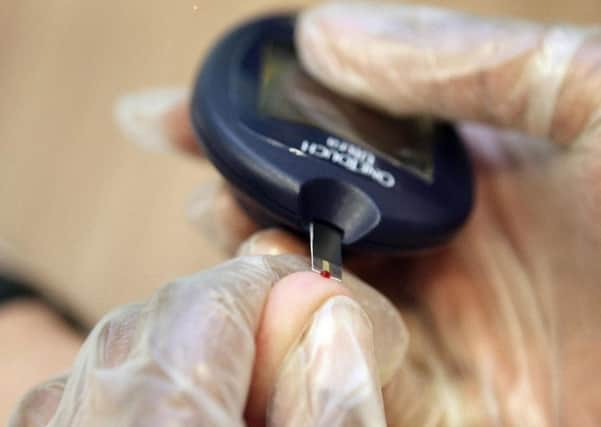Millons at high risk of Type 2 diabetes says new report


Five million people in England have blood sugar levels indicating a high risk of developing Type 2 diabetes, according to a new report published by Public Health England (PHE).
In the South East, it is estimated that 794,171 people are at risk of developing Type 2 diabetes.
Advertisement
Hide AdAdvertisement
Hide AdThe report, compiled by PHE’s National Cardiovascular Health Intelligence Network (NCVIN), provides the most accurate and robust estimate of how many people over 16 in England have blood sugar levels in a range indicating a high risk of developing Type 2 diabetes, otherwise known as non-diabetic hyperglycaemia.
It was commissioned by the NHS Diabetes Prevention Programme (NHS DPP), which will support people in reducing their risk of developing Type 2 diabetes by helping them lose weight, be more active and have a healthier diet. The new estimate further underlines the need to act on Type 2 diabetes, especially as it already results in 22,000 early deaths and costs the NHS £8.8billion every year.
An evidence review also published today by PHE shows programmes similar to the NHS DPP can be successful in preventing 26% of people at high risk of Type 2 diabetes from going on to develop the condition. People supported by diabetes prevention programmes lose on average 1.57kg more weight than those not on a programme aiming to significantly reduce diabetes risk.
Both reports have shaped what the NHS DPP will offer – at least 9 months of information, support, group and one to one sessions on weight loss, physical activity and diet. Practitioners, clinicians, academics and the public are currently being consulted on a proposed outline of the programme. Consultation responses will further inform the programme, with a phased national rollout starting in 2016.
Advertisement
Hide AdAdvertisement
Hide AdDr Michael Baker, Deputy Director of Healthcare Public Health, PHE South East, said: “We know how to lower the risk of developing Type 2 diabetes: lose weight, exercise and eat healthily, but it’s hard to do it alone. PHE’s evidence review shows that supporting people along the way will help them protect their health and that’s what our prevention programme will do.”
Dr Nigel Acheson, Chair of the Diabetes Priority Programme Board and Regional Medical Director (South), NHS England, said: “Reducing people’s risk of developing Type 2 diabetes will improve people’s health and wellbeing as well as cut the costs of the disease to the NHS. That’s why we are supporting people to make small changes to their lifestyle through the Diabetes Prevention Programme.”
Barbara Young, Chief Executive of Diabetes UK, said: “Having high blood glucose levels significantly increases your risk of developing Type 2 diabetes, which is a serious health condition which affects 2.9 million people in England, and can lead to devastating complications such as blindness, amputations and stroke, and ultimately early death.
“This is why it is really important that people at high risk of developing Type 2 diabetes are given evidenced based support to reduce their risk. As well as helping to reduce the human cost of Type 2 diabetes, this would also go a long way to helping to reduce costs to the NHS. The NHS spends 10 per cent of its entire budget managing diabetes and unless we get better at preventing Type 2 diabetes this figure will rise to unsustainable levels.”
Advertisement
Hide AdAdvertisement
Hide AdThe data on non-diabetic hyperglycaemia is broken down by local authority (LA) for the first time, ranging from 8.5% of people in Brighton and Hove to 12.9% in East Sussex. Higher rates are found in areas with large ethnic minority populations or older populations, or both – the groups traditionally at higher risk of Type 2 diabetes.
Lifestyle factors, including weight, physical activity levels and diet, are important like the inherent factors of ageing and ethnic background in determining the risk of developing Type 2 diabetes. The NHS DPP will focus on providing support to participants on changing their behaviour in these areas to reduce their risk.
According to the evidence review, programmes more aligned with the NICE guidance on preventing or delaying the onset of Type 2 diabetes help people lose on average 3kg more weight and significantly reduce blood sugar levels.
Aside from reducing incidences of Type 2 diabetes, the NHS DPP also aims to reduce the life-changing complications associated with the disease, like heart, stroke, kidney, eye and foot problems, and reduce costs to the NHS in the long term.
Advertisement
Hide AdAdvertisement
Hide AdPeople identified with a high risk of developing Type 2 diabetes, either through an NHS Health Check or through an existing blood test result will be offered a place on the NHS DPP when it launches in 2016.
Estimates of non-diabetic hyperglycaeamia in Local Authorities. The data below gives the estimated number of people aged 16 and over who have non-diabetic hyperglycaemia by local authority and the prevalence as a percentage in brackets.
Buckinghamshire 49,541 (11.9%)
Milton Keynes 21,582 (10.6%)
Oxfordshire 58,275 (10.7%)
Bedford 15,411 (11.7%)
Central Bedfordshire 24,098 (11.1%)
Luton 19,594 (11.9%)
Hertfordshire 102,691 (11.1%)
Leicestershire 65,463 (11.9%)
Northamptonshire 64,506 (11.2%)
Warwickshire 53,473 (11.7%)